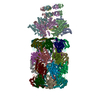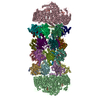[English] 日本語
 Yorodumi
Yorodumi- PDB-7pxd: Substrate-engaged mycobacterial Proteasome-associated ATPase in c... -
+ Open data
Open data
- Basic information
Basic information
| Entry | Database: PDB / ID: 7pxd | ||||||
|---|---|---|---|---|---|---|---|
| Title | Substrate-engaged mycobacterial Proteasome-associated ATPase in complex with open-gate 20S CP - composite map (state B) | ||||||
 Components Components |
| ||||||
 Keywords Keywords | CYTOSOLIC PROTEIN / AAA motor / ATPAse / mycobacterium / proteasome activator / 20S CP | ||||||
| Function / homology |  Function and homology information Function and homology informationprotein pupylation / proteasome binding / proteasome endopeptidase complex / proteasome core complex, beta-subunit complex / threonine-type endopeptidase activity / proteasome core complex, alpha-subunit complex / proteasomal protein catabolic process / proteasome complex / modification-dependent protein catabolic process / protein tag activity ...protein pupylation / proteasome binding / proteasome endopeptidase complex / proteasome core complex, beta-subunit complex / threonine-type endopeptidase activity / proteasome core complex, alpha-subunit complex / proteasomal protein catabolic process / proteasome complex / modification-dependent protein catabolic process / protein tag activity / ATP hydrolysis activity / ATP binding / cytoplasm Similarity search - Function | ||||||
| Biological species |  | ||||||
| Method | ELECTRON MICROSCOPY / single particle reconstruction / cryo EM / Resolution: 4 Å | ||||||
 Authors Authors | Jomaa, A. / Kavalchuk, M. / Weber-Ban, E. | ||||||
| Funding support |  Switzerland, 1items Switzerland, 1items
| ||||||
 Citation Citation |  Journal: Nat Commun / Year: 2022 Journal: Nat Commun / Year: 2022Title: Structural basis of prokaryotic ubiquitin-like protein engagement and translocation by the mycobacterial Mpa-proteasome complex. Authors: Mikhail Kavalchuk / Ahmad Jomaa / Andreas U Müller / Eilika Weber-Ban /  Abstract: Proteasomes are present in eukaryotes, archaea and Actinobacteria, including the human pathogen Mycobacterium tuberculosis, where proteasomal degradation supports persistence inside the host. In ...Proteasomes are present in eukaryotes, archaea and Actinobacteria, including the human pathogen Mycobacterium tuberculosis, where proteasomal degradation supports persistence inside the host. In mycobacteria and other members of Actinobacteria, prokaryotic ubiquitin-like protein (Pup) serves as a degradation tag post-translationally conjugated to target proteins for their recruitment to the mycobacterial proteasome ATPase (Mpa). Here, we use single-particle cryo-electron microscopy to determine the structure of Mpa in complex with the 20S core particle at an early stage of pupylated substrate recruitment, shedding light on the mechanism of substrate translocation. Two conformational states of Mpa show how substrate is translocated stepwise towards the degradation chamber of the proteasome core particle. We also demonstrate, in vitro and in vivo, the importance of a structural feature in Mpa that allows formation of alternating charge-complementary interactions with the proteasome resulting in radial, rail-guided movements during the ATPase conformational cycle. | ||||||
| History |
|
- Structure visualization
Structure visualization
| Movie |
 Movie viewer Movie viewer |
|---|---|
| Structure viewer | Molecule:  Molmil Molmil Jmol/JSmol Jmol/JSmol |
- Downloads & links
Downloads & links
- Download
Download
| PDBx/mmCIF format |  7pxd.cif.gz 7pxd.cif.gz | 1.6 MB | Display |  PDBx/mmCIF format PDBx/mmCIF format |
|---|---|---|---|---|
| PDB format |  pdb7pxd.ent.gz pdb7pxd.ent.gz | Display |  PDB format PDB format | |
| PDBx/mmJSON format |  7pxd.json.gz 7pxd.json.gz | Tree view |  PDBx/mmJSON format PDBx/mmJSON format | |
| Others |  Other downloads Other downloads |
-Validation report
| Summary document |  7pxd_validation.pdf.gz 7pxd_validation.pdf.gz | 1.4 MB | Display |  wwPDB validaton report wwPDB validaton report |
|---|---|---|---|---|
| Full document |  7pxd_full_validation.pdf.gz 7pxd_full_validation.pdf.gz | 1.5 MB | Display | |
| Data in XML |  7pxd_validation.xml.gz 7pxd_validation.xml.gz | 215.2 KB | Display | |
| Data in CIF |  7pxd_validation.cif.gz 7pxd_validation.cif.gz | 336.2 KB | Display | |
| Arichive directory |  https://data.pdbj.org/pub/pdb/validation_reports/px/7pxd https://data.pdbj.org/pub/pdb/validation_reports/px/7pxd ftp://data.pdbj.org/pub/pdb/validation_reports/px/7pxd ftp://data.pdbj.org/pub/pdb/validation_reports/px/7pxd | HTTPS FTP |
-Related structure data
| Related structure data |  13698MC  7px9C  7pxaC  7pxbC  7pxcC M: map data used to model this data C: citing same article ( |
|---|---|
| Similar structure data |
- Links
Links
- Assembly
Assembly
| Deposited unit | 
|
|---|---|
| 1 |
|
- Components
Components
-Proteasome subunit ... , 2 types, 28 molecules 02468IKOQTXZdfHJLMNPRSUVWYab
| #1: Protein | Mass: 26911.039 Da / Num. of mol.: 14 Source method: isolated from a genetically manipulated source Details: The first 7 residues were removed (open gate proteasome) Source: (gene. exp.)  Gene: prcA_1, prcA, prcA_2, C0094_11490, ERS007657_01774, ERS007661_00268, ERS007663_02522, ERS007665_00481, ERS007720_00613, ERS007722_01881 Production host:  #4: Protein | Mass: 30332.006 Da / Num. of mol.: 14 Source method: isolated from a genetically manipulated source Details: Propetide (the first N-terminal 57 residues) is removed Source: (gene. exp.)  Gene: prcB, C0094_11495, DSI38_15610, E5M05_20980, E5M52_20895, E5M78_20920, ERS007665_00482, ERS007670_00434, ERS007679_01035, ERS007720_00612, ERS007722_01880, ERS007741_02624, ERS013471_03478, ...Gene: prcB, C0094_11495, DSI38_15610, E5M05_20980, E5M52_20895, E5M78_20920, ERS007665_00482, ERS007670_00434, ERS007679_01035, ERS007720_00612, ERS007722_01880, ERS007741_02624, ERS013471_03478, ERS023446_02554, ERS024276_00650, ERS094182_01868, F6W99_00699, GCL30_10845, SAMEA2683035_00452 Production host:  References: UniProt: A0A045HFG5, proteasome endopeptidase complex |
|---|
-Protein , 2 types, 8 molecules 1ABCDEFG
| #2: Protein | Mass: 67487.930 Da / Num. of mol.: 7 Source method: isolated from a genetically manipulated source Details: C-terminal extension of Mpa containing GQYL motif which interacts with the proteasome Source: (gene. exp.)  Gene: arc, mpa, C0094_11520, DSI38_15585, E5M05_19030, E5M52_17490, E5M78_17520, ERS007661_01151, ERS007665_00732, ERS007679_01634, ERS007681_02311, ERS007703_01049, ERS007720_01453, ERS007722_00998, ...Gene: arc, mpa, C0094_11520, DSI38_15585, E5M05_19030, E5M52_17490, E5M78_17520, ERS007661_01151, ERS007665_00732, ERS007679_01634, ERS007681_02311, ERS007703_01049, ERS007720_01453, ERS007722_00998, ERS007741_01455, ERS023446_02559, ERS024276_00114, ERS027646_02035, ERS027659_02128, ERS027661_00811, ERS094182_01863, F6W99_00704, FRD82_11355, GCL30_10870, SAMEA2683035_00457 Production host:  #3: Protein | | Mass: 7095.416 Da / Num. of mol.: 1 Source method: isolated from a genetically manipulated source Details: GS residues are left from the TEV cleavage site / Source: (gene. exp.)  Gene: pup, C0094_11500, DSI38_15605, E5M05_20975, E5M52_20890, E5M78_20915, ERS007661_02567, ERS007665_00483, ERS007670_00435, ERS007679_01034, ERS007681_03228, ERS007688_03984, ERS007720_00611, ...Gene: pup, C0094_11500, DSI38_15605, E5M05_20975, E5M52_20890, E5M78_20915, ERS007661_02567, ERS007665_00483, ERS007670_00435, ERS007679_01034, ERS007681_03228, ERS007688_03984, ERS007720_00611, ERS007722_01879, ERS007741_02623, ERS013471_03479, ERS023446_02555, ERS024276_00651, ERS027646_03180, ERS027661_04264, ERS094182_01867, F6W99_00700, FRD82_16980, GCL30_10850, SAMEA2683035_00453 Production host:  |
|---|
-Non-polymers , 2 types, 12 molecules 


| #5: Chemical | ChemComp-ATP / #6: Chemical | ChemComp-MG / |
|---|
-Details
| Has ligand of interest | Y |
|---|
-Experimental details
-Experiment
| Experiment | Method: ELECTRON MICROSCOPY |
|---|---|
| EM experiment | Aggregation state: PARTICLE / 3D reconstruction method: single particle reconstruction |
- Sample preparation
Sample preparation
| Component | Name: Mycobacterial Proteasome-associated ATPase in complex with substrate and open-gate 20SCP Type: COMPLEX / Entity ID: #1-#4 / Source: RECOMBINANT |
|---|---|
| Molecular weight | Value: 1.1 MDa / Experimental value: NO |
| Source (natural) | Organism:  |
| Source (recombinant) | Organism:  |
| Buffer solution | pH: 7.5 |
| Specimen | Embedding applied: NO / Shadowing applied: NO / Staining applied: NO / Vitrification applied: YES |
| Vitrification | Instrument: FEI VITROBOT MARK IV / Cryogen name: ETHANE-PROPANE |
- Electron microscopy imaging
Electron microscopy imaging
| Experimental equipment |  Model: Titan Krios / Image courtesy: FEI Company |
|---|---|
| Microscopy | Model: FEI TITAN KRIOS |
| Electron gun | Electron source:  FIELD EMISSION GUN / Accelerating voltage: 300 kV / Illumination mode: FLOOD BEAM FIELD EMISSION GUN / Accelerating voltage: 300 kV / Illumination mode: FLOOD BEAM |
| Electron lens | Mode: BRIGHT FIELD / Nominal magnification: 105000 X / Nominal defocus max: 2500 nm / Nominal defocus min: 1500 nm / Alignment procedure: COMA FREE |
| Specimen holder | Cryogen: NITROGEN / Specimen holder model: FEI TITAN KRIOS AUTOGRID HOLDER |
| Image recording | Electron dose: 50 e/Å2 / Film or detector model: GATAN K3 (6k x 4k) |
- Processing
Processing
| EM software |
| |||||||||||||||||||||||||||
|---|---|---|---|---|---|---|---|---|---|---|---|---|---|---|---|---|---|---|---|---|---|---|---|---|---|---|---|---|
| CTF correction | Type: PHASE FLIPPING AND AMPLITUDE CORRECTION | |||||||||||||||||||||||||||
| Particle selection | Num. of particles selected: 860718 | |||||||||||||||||||||||||||
| 3D reconstruction | Resolution: 4 Å / Resolution method: OTHER / Num. of particles: 50814 / Symmetry type: POINT | |||||||||||||||||||||||||||
| Atomic model building | Protocol: RIGID BODY FIT / Space: REAL | |||||||||||||||||||||||||||
| Atomic model building |
|
 Movie
Movie Controller
Controller












 PDBj
PDBj








